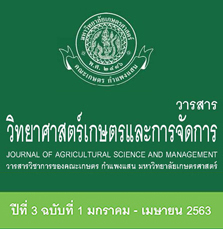Value Added of Dirty Shell Table Eggs by Automatic Egg Washing Machine
Keywords:
table egg, egg washing, dirty shell table eggs, ATP BioluminescenceAbstract
Cleaning up the dirty egg shells will help reduce the amount of dirt and microbes attached to the egg shells. The objective of this research is to study the efficiency of the washing and sanitizing process of each level of dirty egg by automatic washing machine to increase the value of egg with dirty shell. Dirty shells were separated in to 3 levels which are low (L), moderate (M) and high (H) according to the dirty areas on the eggshell based on the updated criteria from the United States Department of Agriculture (USDA) 2000. Thereafter, they were washed by automatic washers. The analysis was relied on cleanliness value derived from total ATP by ATP bioluminescence technique, total viable count (TVC), and contamination of Salmonella spp. before and after washing by the autonomic washers. The results revealed that ATPs and TVCs before washing of L, M, and H groups were 306.0 RLU (Relative Light Unit) and 3.04 log10 CFU/cm2, 520.9 RLU and 3.42 log10 CFU/cm2, and 721.3 RLU and 3.21 log10 CFU/cm2, respectively. ATPs were significantly different from one another (P<0.05), whereas TVCs of each group were not significantly different (P>0.05). After washing, ATPs and TVCs of L, M, and H groups were 132.3 RLU and 1.69 log10 CFU/cm2, 83.8 RLU and 1.81 log10 CFU/cm2, and 210.1 RLU and 1.74 log10 CFU/cm2, respectively. Moreover, ATPs and TVCs before and after washing between groups were significantly different (P<0.05). There was a positive relationship between the Total ATP and TVC values. When the Total ATP values are high, the TVC values are also high in both the pre-wash (R2 = 0.9422) and after-wash (R2 = 0.772) groups. The examination of Salmonella spp. was negative both before and after washing. It could be concluded that eggshell washing could improve eggshell quality of all dirt levels, especially the H group which was the most contaminated and mostly tended to be rejected. Based on USDA (2000), the quality of the H group was 82.8% improved. Moreover, ATP bioluminescence assay could be used instead of conventional bacterial culture and visible examination which have been presently used
References
กานดา ล้อแก้วมณี. 2558. ปัจจัยที่มีผลต่อคุณภาพไข่. ข่าวสารเกษตรศาสตร์ มหาวิทยาลัยเกษตรศาสตร์. ปีที่ 60.
ฉบับที่ 2. ตุลาคม 2557-ตุลาคม 2558.
ณัฐา จริยภมรกุร, วิชัย สุทธิธรรม และ ดรุณี ศรีชนะ. 2558. การสำรวจแบคทีเรียก่อโรคซึ่งปนเปื้อนในไข่ที่วาง
จำหน่ายในเขตอำเภอคลองหลวง จังหวัดปทุมธานี. Thai Journal of Science and Technology.4(1):1-11.
มกอช. 2553. มาตรฐานสินค้าเกษตร เรื่อง ไข่ไก่. มกษ.6702-2553. สำนักมาตรฐานสินค้าเกษตรและอาหาร
แห่งชาติ. กระทรวงเกษตรและสหกรณ์, กรุงเทพฯ.
ประเวทย์ ตุ้ยเต็มวงศ์, ฆรณี ตุ้ยเต็มวงศ์ และ จิรวัฒน์ กันต์เกรียงวงศ์. 2541. การพัฒนาใช้ ATP
Bioluminescence ในการควบคุมสุขาภิบาลโรงงานชำแหละไก่. การประชุมทางวิชาการของ
มหาวิทยาลัยเกษตรศาสตร์ (ครั้งที่ 36: บทคัดย่อ 3-5 กุมภาพันธ์ 2541).
http://kukr.lib.ku.ac.th/db/BKN/search detail/result/6691(10 มกราคม 2561)
อิสรี สายรวมญาติ. 2555. คุณภาพและความปลอดภัยของไข่ไก่เพื่อการบริโภค: การสำรวจตั้งแต่ฟาร์มถึงแหล่งจำหน่าย, วิทยานิพนธ์วิทยาศาสตรมหาบัณฑิต. มหาวิทยาลัยเกษตรศาสตร์, กรุงเทพฯ. 99 น.
European Food Safety Authority. 2005. Opinion of the scientific panel on biological hazards on the request from the commission related to the microbiological risks on washing of table eggs. EFSA J.269:39.
Hutchison, M. L., J. Gittins, A. W. Sparks, T. J. Humphrey, C. Burton and A. Moore. 2004. An assessment of the microbiological risks involved with egg washing under commercial conditions. J. Food Prot. 67:4–11.
Jacqueline P. J. R. D. Miles and F. B. Mather. 2009. Egg Shell Quality. Available Source: https://ufdc.ufl.edu/IR00004262/00001.,December 10,2018.
Messens, W., J. Gittins, S. Leleu and N. Sparks. 2011. Egg decontamination by egg washing, pp. 163-180. In Y. Nys, M. Bain and F. Van Immerseel, eds. Improving the Safety and Quality of Eggs and Egg Products. Woodhead Publishing Limited, Cambridge, UK.
Snedecor. G. W. and W. G. Cochran. 1980. Statistical Methods. Seventh Edition. Ames: Iowa State University Press.
United States Department of Agriculture (USDA). Egg grading manual. Agricultural Handbook N.75,
https://www.ams.usda.gov/sites/default/files/media/Egg Grading Manual (Feb 20,2018)






